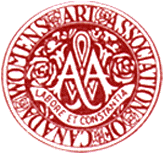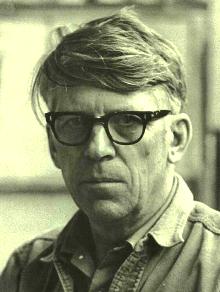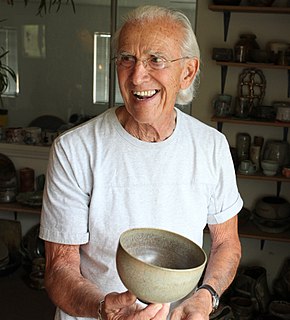
Zema Barbara "Bobs" Cogill Haworth (1900–1988) was a South African-born Canadian painter and potter. She practiced mainly in Toronto, living and working with her husband, painter and teacher Peter Haworth. She co-founded the Canadian Group of Painters with Yvonne McKague Housser, Isabel McLaughlin and members of the Group of Seven.

The California Clay Movement was a school of ceramic art that emerged in California in the 1950s. The movement was part of the larger transition in crafts from "designer-craftsman" to "artist-craftsman". The editor of Craft Horizons, New York-based Rose Slivka, became an enthusiastic advocate of the movement.
Kathleen Frances Daly was a Canadian painter. She is known for her depictions of First Nations and Inuit people of the north of Canada.

Mabel Cawthra Adamson (1871–1943) was a Canadian painter and decorator, who was active in the Arts and Crafts movement in Toronto.

The Women's Art Association of Canada (WAAC) is an organization founded in 1887 to promote and support women artists and craftswomen in Canada, including artists in the visual media, performance artists and writers. At one time it had almost 1,000 members. Although smaller today, it still plays an active role in fundraising and providing scholarships for young artists.

Alice Mary Hagen was a Canadian ceramic artist from Halifax, Nova Scotia. She was trained in china painting, and earned her living through selling painted chinaware and teaching. She was among the artists selected to paint plates for the 1897 Canadian Historical Dinner Service. She gained a high reputation for the quality of her work, for which she won various prizes. She married happily and had two daughters. She continued to paint china while raising her family in Canada and Jamaica. When she was about sixty and her husband had retired she learned to make pottery at her studio in Nova Scotia, and was a pioneer of studio pottery in the area. She continued to produce and sell painted pottery until she was aged 93. Many ceramic artists acknowledged their debt to Alice Hagen as a teacher and an example.

The Canadian Historical Dinner Service, originally called the Cabot Commemorative State Dinner Service, is 204-piece eight-course dinner service with 24 place settings of hand-painted porcelain. It was created in 1896–97 to commemorate the 400th anniversary of the first visit to Canada by a European, John Cabot. The illustrations all have Canadian subjects, and no two pieces are the same.
The Dominion Women's Enfranchisement Association (DWEA) was an organization founded by Dr. Emily Howard Stowe in 1889 to fight for the right of women to vote. Later the association was renamed the Canadian Suffrage Association.
The Canadian Handicrafts Guild was an association of Canadians involved in handicrafts that was founded in Montreal in 1906. At first the goal was to preserve and market traditional home crafts that were seen as being at risk of dying out. Demand for high quality products and a shift towards more "professional" craftspeople and modern designs placed stress on the organization. In 1967 the provincial branches became autonomous, and subsequently evolved separately. At the national level the Guild was merged with the Canadian Craftsman's Association in 1974 to form the Canadian Crafts Council, now the Canadian Crafts Federation.

Rody Kenny Courtice was a Canadian painter and teacher. She was associated with the Group of Seven early in her career, but later moved away into a more individualistic style. She was active in associations of artist and worked for professionalization of their occupation.
Albert Edward Cloutier (1902–1965) was a Canadian painter and graphic designer who painted in a form of intensified realism with abstract plastic forms.

Peter Haworth was a British-born Canadian painter. He was known for his stained glass work.
James Edward Le Rossignol was a Canadian-born American professor of economics with a particular interest in socialism, and also the author of several works of fiction with settings in Quebec.
The Society of Canadian Painter-Etchers and Engravers (CPE) was a non-profit organization of Canadian etchers and engravers.
The Canadian Society of Graphic Art (CSGA), originally called the Graphic Arts Club, was a non-profit organization of Canadian graphic artists. It was founded in 1904, and formally chartered in 1933. At one time it was one of the larger organizations of Canadian artists.

Luke Orton Lindoe was a Canadian painter, sculptor, potter, businessman and ceramic artist who did most of his work in Alberta, Canada. For long periods he was based in Medicine Hat.

The Handweavers Guild of America (HGA) is an association of fiber artists founded in the U.S. in 1969. The guild provides educational programs, conferences, and scholarships for fiber arts students. It publishes the quarterly journal Shuttle Spindle & Dyepot.
Charles Counts (1934–2000) was an American potter, designer, textile artist, quilter, teacher, writer, and activist. Counts worked to preserve the art forms of his native Appalachia, and later moved to Nigeria where he taught until his death.

Donald Lester Reitz was an American ceramic artist, recognized for inspiring a reemergence of salt glaze pottery in United States. He was a teacher of ceramic art at the University of Wisconsin–Madison from 1962 until 1988. During this period, he adapted the pottery firing technique developed in the Middle Ages, which involved pouring salt into the pottery kiln during the firing stage. The method was taught in European ceramic art schools, but largely unknown in United States studio pottery.
Olea Marion Davis was a Canadian artist and craftsperson who worked in architecture and decorative art as well as sculpture and pottery. Her sculptural and ceramic work was exhibited in Montreal, Toronto, Edmonton, as well as at the Brussel's World Fair in 1958 and the Ostende International Show in 1959. Her architectural commissions include friezes, ornamental grills and screens, and lighting fixtures for locations such as the Hotel Vancouver and Pier B.C. in Vancouver, British Columbia. Her work is included in the permanent collection of the Canadian Embassy in Washington, D.C.











